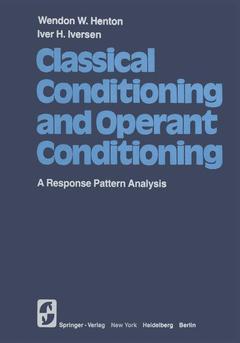Classical Conditioning and Operant Conditioning, Softcover reprint of the original 1st ed. 1978 A Response Pattern Analysis
Langue : Anglais
Auteurs : Henton W.W., Iversen I.H.

Since the appearance of the treatise on "Schedules of Reinforcement" by Ferster and Skinner over two decades ago, the literature in behavior analysis, both experimental and applied, has been dominated by a range of studies dedi cated to providing ever more systematic and refined accounts of these "mainsprings of behavior control. " For the most part, the analysis has been pursued in the best traditions of "scientific methodology" with careful atten tion to the isolation of controlling variables in unitary form. Of late, relatively simple interaction effects have provided an important additional focus for more sophisticated analyses. It is clear, however, from even a cursory survey of the monumental research and conceptual analysis which is represented in this scholarly volume by Henton and Iversen that the surface ofthis complex "be havioral interactions" domain has barely been scratched. The primary focus of this pioneering effort extends the competing response analysis across all experimental schedules, both classical and instrumental, as well as the interactions between the two. Appropriately, the analysis empha sizes overt behavioral interactions, beginning with the simplest case of one operant and one respondent, and inevitably implicating more diverse and subtle interactions. As the analysis expands to include interactions between multiple recorded responses, increasingly more precise empirical specifications ofrecip rocal interactions in response probabilities are revealed independently of con ventional procedural labels (i. e. , operants, respondents, collaterals, adjunc tives, etc. ) and traditional theoretical distinctions.
Introduction: Different Views of Psychology.- Structural Phrenology.- Behavioral Phrenology.- Reinforcer Value: An Example of a Developing Phrenology.- Functional Relationships: An Empirical Alternative.- References.- Section I: Concurrent Classical and Operant Conditioning Procedures.- 1. Review of Classical-Operant Conditioning, Parameter by Parameter.- History: A Confluence of Three Traditions.- Emotional States.- Classical Conditioning.- Classical-Operant Interactions.- Theoretical Positions Briefly Considered.- Experimental Analysis: General Methods.- Subjects.- Conditioning Procedures.- Dependent Variables.- Negative Classical Conditioning Scheduled with Positive Operant Conditioning.- Classical Conditioning Variables.- Operant Conditioning Variables.- Subject Variables.- Negative Classical Conditioning Scheduled with Negative Operant Conditioning.- Classical Conditioning Variables.- Operant Conditioning Variables.- Subject Variables.- Positive Classical Conditioning Scheduled with Positive Operant Conditioning.- Classical Conditioning Variables.- Operant Conditioning Variables.- Subject Variables.- Positive Classical Conditioning Scheduled with Negative Operant Conditioning.- Concluding Remarks.- References.- 2. Empirical Analysis of Concurrent Classical-Operant Schedules.- Interactions between Sidman Avoidance and Appetitive Classically Conditioned Responses (Experiment I).- Experiment I.- Discussion.- Concurrent Response Rates During Positive Classical-Positive Operant Conditioning (Experiments II and III).- Experiment II.- Experiment III.- Discussion.- Concurrent Response Rates During Preevent Stimuli (Experiments IV, V, VI, and VII).- Experiment IV.- Experiment V.- Experiment VI.- Experiment VII.- Discussion.- Interactions Between Programmed and Superstitious Operants (Experiment VIII).- Experiment VIII.- Discussion.- Suppression of Classically Conditioned Responses by Superimposed Operant Responses (Experiment IX).- Experiment IX.- Discussion.- Summary.- References.- Section II: Operant Conditioning Procedures.- 3. Concurrent Schedules: Response Versus Reinforcement Interaction.- The Issue of Response Versus Reinforcement Interaction.- Response Independence and Reinforcement Interaction.- Direct or Indirect Reinforcement Interaction.- Response Pattern Reciprocity in Concurrent FR VI Schedules (Experiments I and II).- Experiment I.- Experiment II.- Discussion.- Changeover Responses Under Discriminative Control with Discrete-Trial Procedures (Experiments III, IV, and V).- Experiment III.- Experiment IV.- Experiment V.- Discussion.- Observing Responses with Signaled Reinforcement (Experiments VI, VII, and VIII).- Experiment VI.- Experiment VII.- Experiment VIII.- Discussion.- Superstitious Responding with Response-Independent Reinforcement (Experiment IX).- Experiment IX.- Discussion.- Concluding Comments.- References.- 4. Concurrent Responses with Multiple Schedules.- Explanations of Behavioral Contrast.- Component Duration and Collateral Responses (Experiment I).- Experiment I.- Discussion.- Positive Contrast and Collateral Responses (Experiment II).- Experiment II.- Discussion.- Multi-response Interactions and Local Behavioral Contrast (Experiment III).- Discussion.- Concluding Comments.- A Response-Displacement Model of Positive Contrast.- Collateral Responses in Multiple Schedules.- Conclusion.- References.- 5. Collateral Responses with Simple Schedules.- Reinforced Responses Interacting with Collateral Responses.- Pattern Reciprocity Between FR Responding and Collateral Licking (Experiments I and II).- Experiment I.- Experiment II.- Discussion.- Pattern Dependency Between FR Responding and Collateral Licking (Experiment III).- Experiment III.- Discussion.- Pattern Interdependence Between FR Responding and Collateral Licking (Experiment IV).- Experiment IVA.- Experiment IVB.- Discussion.- Pauses and Collateral Responses with Reinforcement Omission (Experiment V).- Experiment VA.- Experiment VB.- Experiment VC.- Discussion.- Interresponse Times and Collateral Responses (Experiment VI).- Experiment VI.- Discussion.- Concluding Comments.- References.- Section III: Classical Conditioning Procedures.- 6. Response Patterning in Classical Conditioning.- Review of Conditioning and Competing Responses.- Simple Classical Conditioning (Experiment I).- Delay Conditioning (Exeriment IA).- External Inhibition (Experiment IB).- Extinction (Experiment IC).- Delay Conditioning plus Inhibition of Extinction (Experiment ID).- Delay Conditioning: Replication (Experiment IE).- Summary.- Concurrent Classical Conditioning (Experiments II, III, and IV).- Concurrent Delay-Trace Conditioning (Experiments IIA, B, and C).- Concurrent Delay-Delay Conditioning (Experiments IID and E).- Concurrent Delay-Delay Conditioning: Systematic Replication (Experiment III).- Concurrent Trace-Trace Conditioning (Experiment IV).- Summary.- References.
Date de parution : 10-2011
Ouvrage de 356 p.
17x24.4 cm
Disponible chez l'éditeur (délai d'approvisionnement : 15 jours).
Prix indicatif 52,74 €
Ajouter au panierThème de Classical Conditioning and Operant Conditioning :
© 2024 LAVOISIER S.A.S.



